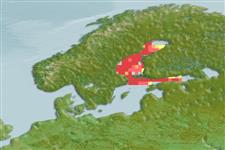Common names from other countries
>
Salmoniformes (Salmons) >
Salmonidae (Salmonids) > Coregoninae
Etymology: Coregonus: Greek, kore = pupils of the eye + Greek, gonia = angle (Ref. 45335).
More on author: Linnaeus.
Environment: milieu / climate zone / depth range / distribution range
Écologie
marin; eau douce; saumâtre benthopélagique; anadrome (Ref. 51243); profondeur 30 - ? m. Temperate; 66°N - 59°N, 16°E - 31°E
Europe: Baltic basin, lakes of upper Volga drainage (Seliger, Vseluga, Perejaslavskoe), some lakes of White sea basin and North Sea basin east of Elbe drainage. Anadromous in Gulf of Finland and marine in northernmost freshened part of Gulf of Bothnia; north to about 69° N in Lake Inari, northern Finland; lower Rhine (now extirpated). Frequently stocked in lakes and reservoirs in Germany and Poland.
Taille / Poids / Âge
Maturity: Lm ? range ? - ? cm
Max length : 48.0 cm TL mâle / non sexé; (Ref. 556); common length : 20.0 cm TL mâle / non sexé; (Ref. 556); poids max. publié: 1.0 kg (Ref. 556); âge max. reporté: 10 années (Ref. 593)
Épines dorsales (Total): 0; Rayons mous dorsaux (Total): 11-13; Épines anales 0; Rayons mous anaux: 13 - 17
Lacustrine and marine in open water. At sea, forages close to coast (Ref. 59043). Forms pelagic schools in deeper lakes (Ref. 4779). Spawns along shores, at 3-10 m depth, rarely to 22 m depth or just below surface. Spawns deeper in clear lakes and closer to surface in lakes with humic waters (Ref. 59043). Spawns on shallow sand or gravel substrate. Anadromous in the Baltic. Feeds on planktonic crustaceans (Ref. 4779).
Ascend a short distance up the rivers in shoals in late August to mid-October. Mature in the second year (lacustrine forms later) and the young ones descend in late summer (Ref. 4779).
Svetovidov, A.N., 1984. Salmonidae. p. 373-385. In P.J.P. Whitehead, M.-L. Bauchot, J.-C. Hureau, J. Nielsen and E. Tortonese (eds.) Fishes of the north-eastern Atlantic and the Mediterranean. UNESCO, Paris. vol. 1. (Ref. 4779)
Statut dans la liste rouge de l'IUCN (Ref. 130435)
CITES (Ref. 128078)
Not Evaluated
Menace pour l'homme
Harmless
Utilisations par l'homme
Pêcheries: commercial; Aquaculture: expérimental
Outils
Articles particuliers
Télécharger en XML
Sources Internet
Estimates based on models
Preferred temperature (Ref.
115969): 2.1 - 4.5, mean 2.6 (based on 38 cells).
Phylogenetic diversity index (Ref.
82804): PD
50 = 0.5000 [Uniqueness, from 0.5 = low to 2.0 = high].
Bayesian length-weight: a=0.00468 (0.00388 - 0.00563), b=3.21 (3.17 - 3.25), in cm Total Length, based on LWR estimates for this species (Ref.
93245).
Niveau trophique (Ref.
69278): 3.1 ±0.17 se; based on food items.
Résilience (Ref.
120179): Milieu, temps minimum de doublement de population : 1,4 à 4,4 années (K=0.3-0.7; tm=2; tmax=10; Fec=2,000).
Fishing Vulnerability (Ref.
59153): Moderate vulnerability (35 of 100).
Climate Vulnerability (Ref.
125649): High vulnerability (62 of 100).
